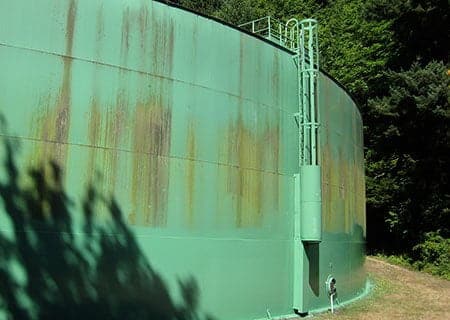 Some large water storage tanks can be found in very remote areas; away from power, internet, and hidden in forest cover. We recently spoke with an operator who has such a tank a ½ mile away from his facility. He also mentioned that he and his technicians have been manually checking the tank multiple times per day for decades! Talk about health benefits from all that hiking!
Some large water storage tanks can be found in very remote areas; away from power, internet, and hidden in forest cover. We recently spoke with an operator who has such a tank a ½ mile away from his facility. He also mentioned that he and his technicians have been manually checking the tank multiple times per day for decades! Talk about health benefits from all that hiking!
As you can imagine, he was tired of checking tank levels this way and wanted to learn about what his options were. So we thought we would share with you what we shared with him.
With that much distance between his facility and the tank, the logical place to start is to look into using a wireless solution. One of the most common wireless methods is to take advantage of cellular networks. For tank level measurement, this would involve integrating a level sensor (either ultrasonic or submersible pressure) with a controller and cellular modem.
Now-a-days even though many rural areas have great cellular coverage, not all remote locations are covered. Since the area this operator was working in didn’t have any cellular coverage at all, we had to move on to the next option.
Just like cellular, using Satellite for tank level monitoring involves integrating a level sensor with a controller but with a satellite modem instead.
Satellite offers much better coverage, in fact, 100% of North America is covered by a single provider. So coverage was of no concern.
But the signal getting blocked by trees was still a concern. Depending on how dense the tree cover was and the type of trees (deciduous vs. coniferous) a signal may not be interrupted by some tree cover.
However, the largest obstacle with Satellite was the pricing. To begin with, the hardware is a lot more expensive than cellular. Think 5 – 10x as much. Furthermore, the monthly data costs are a lot more. Most of our customers that use Satellite are forced to minimize the data they can get. For some of them, the network coverage outweighs this. On the other hand, many others require a lot more than 1 – 2 readings per day and are not willing to pay the premium.
Radio has been around for a long time and it has been proven to be a reliable technology.
Radio has some major advantages. One, they don’t cost much. For a few hundred dollars you can get an industrial grade set including a transmitter and a receiver. Second, you don’t have to pay a monthly network fee like you would with cellular or satellite.
But the major problem with radios is that you must have a line of sight from the transmitter to the receiver, and in a heavily wooded area this may not be possible.
Another problem that affects all wireless signals is inclement weather. For example, with our customer, he mentioned that the winters were “brutal” and that it wasn’t extraordinary to see 300 inches of snow. Good luck trying to get wireless signals through a blizzard.
The last option to consider is running cable a ½ mile from the facility to the tank. This is expensive. Not only do you have to pay for all of that cable, but you will need to pay for conduit pipe to protect it and then pay for the labor to bury it all
That way, you won’t have to worry about all of those issues that come with wireless solutions like tree cover, bad weather, etc.
You may be thinking that a ½ mile cable run is too long and that the signal wouldn’t make that distance. This is why we only recommend using 4-20 mA or digital signals when making long cable runs like this.
None of the remote monitoring options above are a home run for this particular application, but since the wired option would be the most reliable this is what we recommended.
Make sure you understand all of the details of your application and work with your solution provider to determine what will work best for your specific application. Any of the options listed above have the potential to be the best option depending on the details of your situation.
If you have questions about monitoring level or pressure in remote locations, please give us a call, and we will be happy to point you in the right direction.
top image credit: David Burn via flickr cc cropped